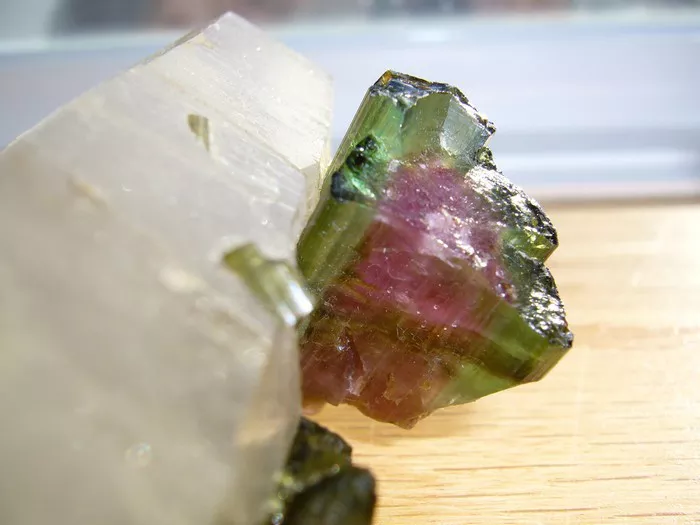Watermelon tourmaline is a stunning gemstone known for its unique coloration, which resembles the layers of a watermelon. With its vibrant green outer layer, followed by a pink or red inner core, watermelon tourmaline is highly prized by collectors and jewelry enthusiasts alike. However, due to its popularity, there are synthetic and imitation versions of watermelon tourmaline on the market. To ensure that you’re purchasing an authentic watermelon tourmaline, it’s essential to know how to distinguish between genuine and fake stones.
Watermelon tourmaline is a type of tourmaline gemstone characterized by its distinctive color zoning, which resembles the layers of a watermelon. This natural coloration is caused by variations in the chemical composition of the crystal as it forms. Genuine watermelon tourmaline is highly sought after for its beauty and rarity, making it a valuable addition to any gemstone collection or jewelry piece.
However, with the increasing demand for watermelon tourmaline, there has been a rise in the production of synthetic and imitation stones that mimic its appearance. To avoid being deceived by fake or misrepresented gemstones, it’s crucial to familiarize yourself with the characteristics of authentic watermelon tourmaline and the methods for identifying them.
Understanding Watermelon Tourmaline
Watermelon tourmaline is a variety of the mineral tourmaline, which is a complex boron silicate mineral with a unique crystal structure. Tourmaline occurs in a wide range of colors, including green, pink, red, blue, and multicolored varieties. Watermelon tourmaline specifically exhibits a green outer layer surrounding a pink or red inner core, creating a distinctive “watermelon” pattern.
In addition to its striking coloration, watermelon tourmaline is valued for its transparency, clarity, and natural beauty. Genuine watermelon tourmaline is typically found in mineral deposits around the world, including Brazil, Madagascar, and Afghanistan.
How to Tell if Watermelon Tourmaline Is Real
When evaluating a watermelon tourmaline gemstone, there are several key characteristics to consider to determine its authenticity:
Color: The most prominent feature of watermelon tourmaline is its unique color zoning, with a green outer layer transitioning into a pink or red inner core. Authentic watermelon tourmaline will exhibit a natural, gradient-like color pattern, with smooth transitions between the green and pink/red sections. Be wary of stones with unnatural or abrupt color changes, as they may be synthetic or artificially treated.
Clarity: Watermelon tourmaline is typically transparent to translucent, allowing light to pass through the gemstone. Genuine stones will exhibit clarity and brightness, with minimal inclusions or imperfections that may detract from their beauty. While some inclusions are natural and acceptable, excessively cloudy or included stones may indicate that they are not genuine.
Cut: The cut of a watermelon tourmaline can greatly impact its appearance and value. Well-cut stones will showcase the gemstone’s natural color zoning and maximize its brilliance and sparkle. Look for symmetrical cuts with smooth, polished surfaces that enhance the beauty of the watermelon pattern.
Hardness: Tourmaline has a hardness of 7 to 7.5 on the Mohs scale, making it relatively durable and resistant to scratching. You can perform a scratch test using materials of known hardness, such as quartz or corundum, to see if the watermelon tourmaline is genuine. If the gemstone is easily scratched or damaged, it may be an indication that it is not authentic.
Fluorescence: Some watermelon tourmaline gemstones may exhibit fluorescence under ultraviolet (UV) light, which can help differentiate them from imitations. Place the gemstone under a UV light source and observe any fluorescence or phosphorescence that occurs. While not all genuine watermelon tourmaline will fluoresce, the presence of fluorescence can be a positive indication of authenticity.
Specific Gravity: The specific gravity of a gemstone refers to its density relative to that of water. Genuine watermelon tourmaline will have a specific gravity of approximately 3.06 to 3.25, depending on its chemical composition and crystal structure. To perform a specific gravity test, you can use a gemological scale or immerse the gemstone in a liquid with a known specific gravity and compare the results.
Professional Certification: If you’re still unsure about the authenticity of a watermelon tourmaline, consider seeking professional certification from a reputable gemological laboratory. Gemologists can conduct a series of tests, including spectroscopy and chemical analysis, to determine the composition and origin of the gemstone accurately.
Conclusion
In conclusion, identifying genuine watermelon tourmaline requires careful examination and knowledge of its key characteristics. By familiarizing yourself with the natural color zoning, clarity, cut, hardness, fluorescence, specific gravity, and professional certification methods, you can confidently determine whether a watermelon tourmaline is real or not. Whether you’re purchasing a watermelon tourmaline for its beauty or investment value, being able to distinguish between authentic and fake gemstones is essential for making informed decisions in the gemstone market.


